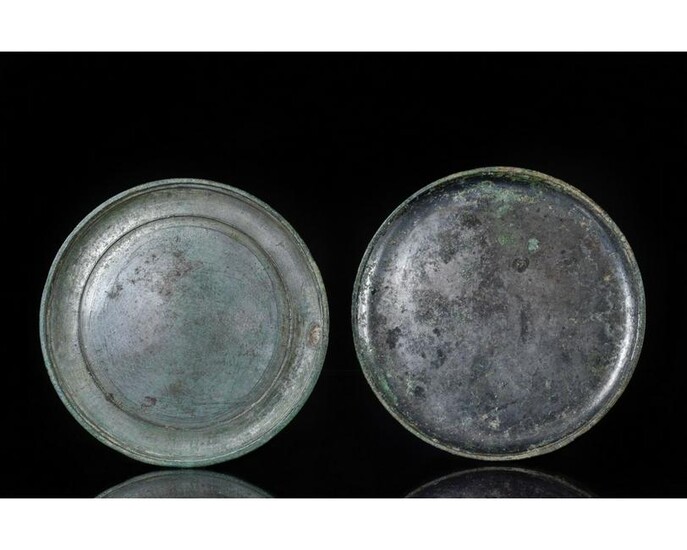ROMAN TINNED BRONZE CIRCULAR DOUBLE MIRROR
Ca. 100-300 AD. Roman. A rare early Roman bronze circular double mirror. This two-part mirror consists of two circular discs with raised lips, which nest together when the mirror is closed to protect the reflecting surface. Both halves are well preserved and the exterior surfaces are decorated with incised concentric rings, while the interiors were polished to function as mirrors. Mirrors in the Graeco-Roman world were made of various materials - mostly copper alloy, but silver and iron examples have also been found. Mirrors were personal items, often owned by women. The earliest surviving pieces date to the Mycenaean period ca. 1200-1100 BC, with bone and ivory handles carved with animal motifs. Greek hand mirrors were made in one piece from the 7th cent. BC and became more elaborate with time. Roman mirrors from the Augustan period onwards have been found in most provinces of the empire and, like this item, they displayed applied engravings, decorative plaques on the reverse, or figurative ornament. For a comprehensive study of Roman mirrors, see Zahlhaas, G. (1975). Römische Relief Spiegel. Lassleben. Size: L: set of 2: 7mm / W:115mm ; 280g. Provenance: Property of a London gentleman, part of his family collection formed in the 1980s.
[ translate ]View it on
Sale price
Estimate
Time, Location
Auction House
Ca. 100-300 AD. Roman. A rare early Roman bronze circular double mirror. This two-part mirror consists of two circular discs with raised lips, which nest together when the mirror is closed to protect the reflecting surface. Both halves are well preserved and the exterior surfaces are decorated with incised concentric rings, while the interiors were polished to function as mirrors. Mirrors in the Graeco-Roman world were made of various materials - mostly copper alloy, but silver and iron examples have also been found. Mirrors were personal items, often owned by women. The earliest surviving pieces date to the Mycenaean period ca. 1200-1100 BC, with bone and ivory handles carved with animal motifs. Greek hand mirrors were made in one piece from the 7th cent. BC and became more elaborate with time. Roman mirrors from the Augustan period onwards have been found in most provinces of the empire and, like this item, they displayed applied engravings, decorative plaques on the reverse, or figurative ornament. For a comprehensive study of Roman mirrors, see Zahlhaas, G. (1975). Römische Relief Spiegel. Lassleben. Size: L: set of 2: 7mm / W:115mm ; 280g. Provenance: Property of a London gentleman, part of his family collection formed in the 1980s.
[ translate ]


